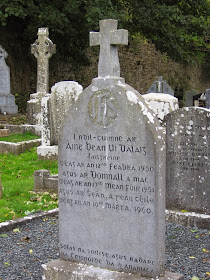Depending on where we traveled in Ireland, we either predominantly heard English—although the variety of accents sometimes had us
wondering—or a mix of both English and another language. That language, we
assumed, was Irish.
You could see
Irish everywhere. Many signs were printed first in Irish, then followed by
English. And that would make sense in a young country still struggling to
regain its own identity.
But “young” isn’t the term I’d have in mind when thinking
about a language with a history like Irish. After all, in its primitive form,
it had been inscribed in sites found throughout Ireland,
as well as around the west coast of Great Britain, from as early as the fourth century.
On our very first day in Ireland,
after we took the bus from the airport to the Dublin
train station to complete our journey to Cork,
the station announcements came over the public address system first in Irish,
then in English. Reading them concurrently on the LED system at the front of the
train while each Irish announcement was played was an interesting experience in
matching the written word with the phonetics.
When we took our travels away from the cities and into the
rural areas of counties Limerick, Tipperary and
Kerry—especially in County Kerry—we began to see more signs of this language
considered the native tongue of Ireland.
And yet, when we walked the cemeteries, it seemed a surprise to encounter a
headstone engraved in Irish rather than English.
Because I know very little about the Irish language, I have
no way to understand what those headstones were saying. Of course, it is easy to
presume the stones were announcing the name of the departed, along with significant
dates and perhaps relationships.
With one readable headstone, I tried my hand at Google
Translate. Though the program includes the option of translation from Irish,
what I typed into the app yielded not much more than gibberish. Either I
transcribed some letters incorrectly, or the system had some glitches, I reasoned, so
I tried a reverse process. Guessing the word “Feabra” might mean February, I
tried entering February in the English box in Google Translate to see what the
Irish result would yield. Surprise: February in Irish is spelled Feabhra, not Feabra. Perhaps we were dealing
with a dyslexic engraver. Or a poor speller.
If I were able to intuit some of the other words on the
headstone, I might have guessed my way through—and found some more misspellings—but
I’m afraid the Irish language still has me mystified. Still, judging by the
patterns of the words, the stone served as memorial for three people, who
presumably died between the twelfth of February in 1950 and the tenth of March,
ten years later. Whatever the details, the record is still there for the world
to read at the graveyard of Castletown-Conyers in the Catholic parish of
Ballyagran in County
Limerick.
Photograph courtesy Chris Stevens.
Photograph courtesy Chris Stevens.

go raibh maith agat
ReplyDeleteWendy, I'm certainly glad Google Translate recognized that one!
DeleteIt seems to me to be a difficult language to learn unless you have heard it growing up.
ReplyDeleteColleen, it sounded like a Scandinavian or Germanic language to me. I haven't even heard enough of it to form much of a concept about it. I'm certainly thankful that my husband's ancestors weren't from a place now part of the Gaeltacht! It helped to be able to find my way through the townlands--and through the reference books--in English.
DeleteThere are a lot of old cemeteries near me that I visit for Find A Grave and the gravestones are written in old German. I've gotten to the point where I know "Here Lies the Bones of" ...:)
ReplyDeleteNot only is it a case of needing to learn a bit of the other language, but also to recognize the style of lettering and "handwriting" appearance, too. I imagine that would be a challenge in reading those German headstones.
DeleteThis makes me think about a booth I saw at a family history conference. The company adds QR codes to headstones and then as individuals visit a grave with that imbedded in it, with the help of a cell phone, you can pull up a biography and pictures of the individual who died. Wouldn't it be wonderful if something like that could help translate headstones in a different language? Although I have to admit, the thought of attaching anything modern to such a beautiful old headstone makes me a little uncomfortable.
ReplyDeleteI am wondering, Michelle, if that would be a feature to be added to new headstones, rather than inserted on those already standing. It certainly would seem out of place on a historic memorial! However, if it were added in an unobtrusive place--or people just learn to get accustomed to it--it could be a nice way to share a person's story. It will be interesting to see how quickly a concept like this catches on--if at all.
Delete